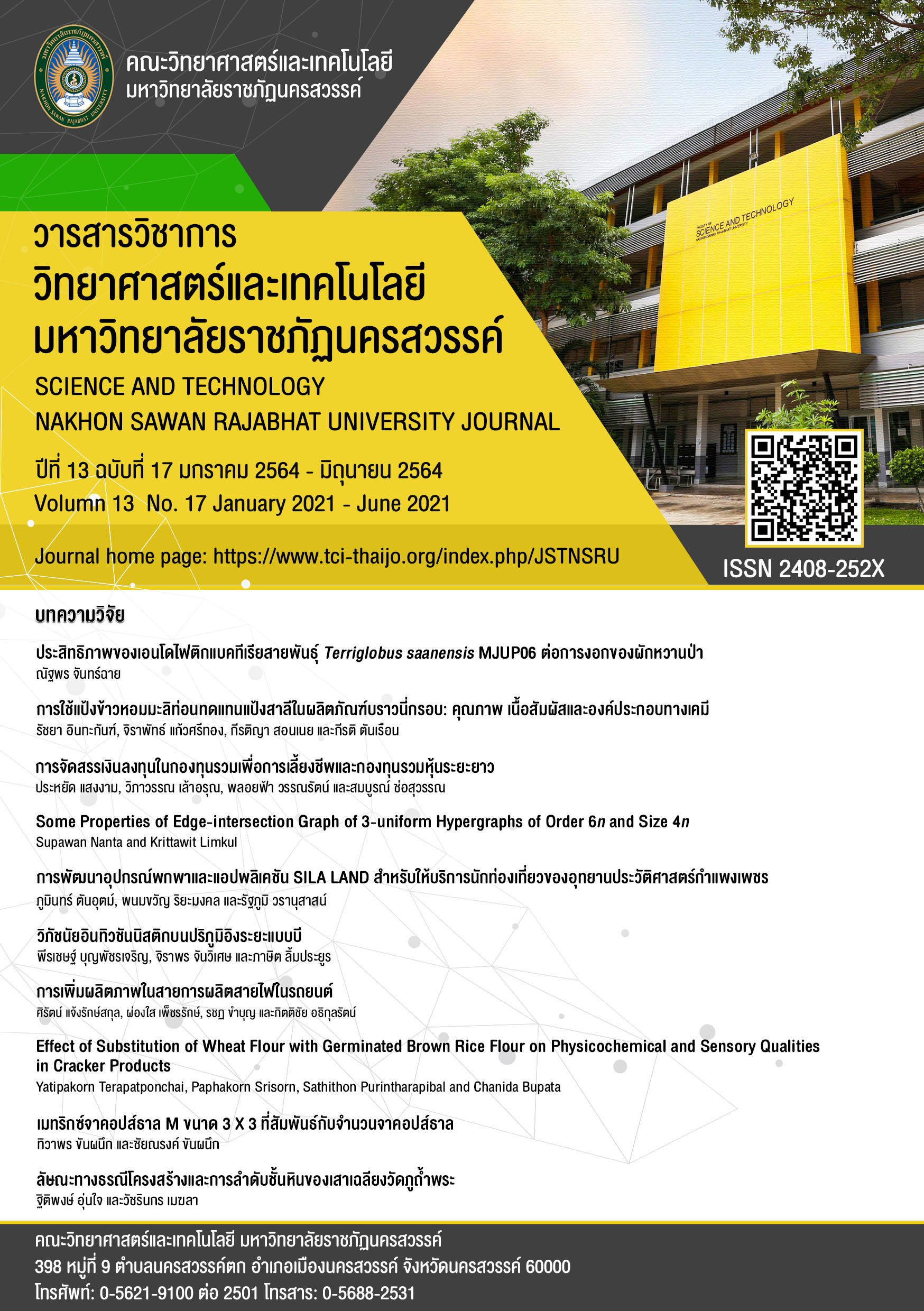ประสิทธิภาพของเอนโดไฟติกแบคทีเรียสายพันธุ์ Terriglobus saanensis MJUP06 ต่อการงอกของผักหวานป่า
Keywords:
Endophytic bacteria, Terriglobus saanensis MJUP06, Phak Wan Pa, GerminationAbstract
Phak Wan Pa (Melientha suavis Pierre.) is a plant found during certain seasons. It was found that endophytic bacterium strain Terriglobus saanensis MJUP06 indicated nitrogen fixation properties to Phak Wan Pa. This study aimed to study the efficiency of T.saanensis MJUP06 affects germination of Phak Wan Pa. The results showed that the soaking time of seedling of 10% T. saanensis MJUP06 inoculation solution for 1 hour had the highest germination rate of 86.75% while, the lowest mean number of days to germination was 34.28 days and the highest germination index was 2.73. The studies on plant growth after 49 days planting found that the soaking time with 10% T. saanensis MJUP06 inoculation solution for 1 hour showed the highest value of stem height, root length and no. of leaves of 11.23 cm, 10.65 cm and 7.73 blades, respectively with statistically significant difference compared with the other methods (p<0.05). From the results obtained, T. saanensis MJUP06 could be use as the inoculation solution to improve the germination efficiency of Phak Wan Pa and further apply for other crops to increasing the breeding survival rate.
References
จวงจันทร์ จำปาทอง และกุลวดี มาสิน. (2561). การคัดกรองฤทธิ์ทางชีวภาพจากแบคทีเรียที่แยกได้จากดินบริเวณที่ทำการเกษตรกรรมในเขตภาคกลาง. วารสารวิชาการ วิทยาศาสตร์และเทคโนโลยี มหาวิทยาลัยราชภัฎนครสวรรค์, 10(11), 59-74.
ณัฐพร จันทร์ฉาย และวรวุฒิ งามพิบูลเวท. (2561). การแยกและการคัดเลือกแบคทีเรียเอนโดไฟต์ตรึงไนโตรเจนในรากผักหวานป่า (รายงานการวิจัย). แพร่: มหาวิทยาลัยแม่โจ้-แพร่
เฉลิมพระเกียรติ.
พงษ์เทพ สุวรรณวารี, พงษ์ฤทธิ์ ครบปรัชญา, หนูเดือน เมืองแสน, ดวงกมล แม้นศิริ, ทักษิณ อาชวาคม และวารินทร์ บุญเรียม. (2560). คุณค่าทางโภชนาการของพืชกินได้ในพื้นที่สงวนชีวมณฑลสะแกราชและพื้นที่ในมหาวิทยาลัยเทคโนโลยีสุรนารี จังหวัดนครราชสีมา ภายใต้โครงการอนุรักษ์พันธุกรรมพืชอันเนื่องมาจากพระราชดำริ สมเด็จพระเทพรัตนราชสุดาฯ สยามบรมราชกุมารี-มาหาวิทยาลัยเทคโนโลยีสุรนารี (อพ.สธ.มทส.) (รายงานการวิจัย). นครราชสีมา: มหาวิทยาลัยเทคโนโลยีสุรนารี.
สุจิตตรา ปะนันโต, ภาคภูมิ ตันเตชสาธิต, ศิริลักษณ์ จิตรอักษร, รังสฤษฏ์ กาวีต๊ะ และกรรณิการ์
สัจจาพันธ์. (2556). เอนโดไฟติกแบคทีเรียและผลในการส่งเสริมการเจริญเติบโตของข้าว. วารสารแก่นเกษตร, 41(4), 457-468.
สุทธวรรณ สุพรรณ, ประดับรัฐ ประจันเขตต์ และสิริแข พงษ์สวัสดิ์. (2559). การใช้แบคทีเรียตรึงไนโตรเจนร่วมกับวัสดุตัวกลางทางชีวภาพเพื่อการส่งเสริมการเจริญของพืช. วารสารวิทยาศาสตร์ และเทคโนโลยี มหาวิทยาลัยเทคโนโลยีราชมงคลธัญบุรี, 6(2), 17-28.
Ahmad, M., H. Nangyal, M. Imran and F. Ullah. (2016). Optimization of protocol for surface sterilization and callus induction for three rice varieties. Am-Eurasian J Agri Environ Sci, 16(2), 357-361.
Chen, Z., X. Sheng, L. He, Z. Huang & W. Zhang. (2013). Effects of root inoculation with bacteria on the growth, Cd uptake and bacterial communities associated with rape grown in Cd-contaminated soil. Journal of Hazardous Materials, 244-245(15), 709-717.
Han, J., D. Xia, L. Li, L. Sun, K. Yang & L. Zhang. (2009). Diversity of culturable bacteria isolated from root domains of moso bamboo (Phyllostachys edulis). Microb Ecol., 58, 363-373.
Mitraa, S., K. Pramanika, P.K. Ghoshb, T. Sorena, A. Sarkarc, R.S. Deyd, S. Pandeye & T.K. Maiti. (2018). Characterization of Cd-resistant Klebsiella michiganensis MCC3089 and its potential for rice seedling growth promotion under Cd stress. Microbiological Research, 210, 12–25.
Pramanik, K., S. Mitra, A. Sarkar, T. Soren & T.K. Maiti. (2017). Characterization of cadmium-resistant Klebsiella pneumoniae MCC3091 promoted rice seedling growth by alleviating phytotoxicity of cadmium. Environ. Sci. Pollut. Res, 24, 24419–24437.
Schwyn, B. & J.B. Neilands. (1987). Universal chemical assay for the detection and determination of siderophores. Analytical Biochemistry, 160(1), 47-56.



